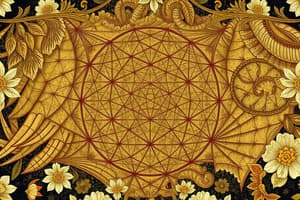Podcast
Questions and Answers
How is the domain represented in set builder notation?
How is the domain represented in set builder notation?
- {x | a < x < b}
- {x | x > a and x < b} (correct)
- {x | x ≤ a or x ≥ b}
- {x | x = a or x = b}
What does scanning from bottom to top along the y-axis help identify?
What does scanning from bottom to top along the y-axis help identify?
- The least y-value only
- The range of y-values (correct)
- The greatest x-value only
- The domain of the x-values
What type of questions are asked to determine if a graph is a function?
What type of questions are asked to determine if a graph is a function?
- Does each x-value correspond to exactly one y-value? (correct)
- Is the least y-value included?
- Is the greatest x-value included?
- Is the domain represented in correct notation?
Which of the following statements is false regarding domain and range?
Which of the following statements is false regarding domain and range?
Which notation is commonly used to represent the range of a function?
Which notation is commonly used to represent the range of a function?
What defines the domain of a function?
What defines the domain of a function?
How is the range of a function described?
How is the range of a function described?
In which scenario would the domain be written as 'all real numbers'?
In which scenario would the domain be written as 'all real numbers'?
Which representation is correct for a finite domain?
Which representation is correct for a finite domain?
When scanning the x-axis for a continuous graph, which action is performed?
When scanning the x-axis for a continuous graph, which action is performed?
What must be true for a set of ordered pairs to represent a function?
What must be true for a set of ordered pairs to represent a function?
How can the range of a continuous function be represented?
How can the range of a continuous function be represented?
What is the independent variable in a function?
What is the independent variable in a function?
What symbol in set builder notation indicates that an endpoint is included?
What symbol in set builder notation indicates that an endpoint is included?
Which of the following represents an OPEN interval in set builder notation?
Which of the following represents an OPEN interval in set builder notation?
In set builder notation, how would you represent a domain with a lowest point of 3 included and no upper limit?
In set builder notation, how would you represent a domain with a lowest point of 3 included and no upper limit?
Which notation would be appropriate for a range that includes all values greater than or equal to -1?
Which notation would be appropriate for a range that includes all values greater than or equal to -1?
If a graph has a least x-value of 4 (included) and a greatest x-value of 10 (not included), what is the set builder notation for the domain?
If a graph has a least x-value of 4 (included) and a greatest x-value of 10 (not included), what is the set builder notation for the domain?
What is the representation in set builder notation for a range that includes all real numbers less than 5?
What is the representation in set builder notation for a range that includes all real numbers less than 5?
If a graph indicates a least y-value of -2 (not included) and a greatest y-value of 3 (included), how should the range be expressed?
If a graph indicates a least y-value of -2 (not included) and a greatest y-value of 3 (included), how should the range be expressed?
For a function with endpoints at 1 and 4, both included, how is the domain represented in set builder notation?
For a function with endpoints at 1 and 4, both included, how is the domain represented in set builder notation?
Flashcards
Domain
Domain
The set of all possible input values (x-values) for a function. Think of it as all the numbers you can plug into the function.
Range
Range
The set of all possible output values (y-values) for a function. Think of it as all the numbers you get out after plugging in the inputs.
Discrete Graph
Discrete Graph
A graph is discrete if it consists of separate, distinct points. You can't draw it without lifting your pencil.
Continuous Graph
Continuous Graph
Signup and view all the flashcards
Discrete Representation
Discrete Representation
Signup and view all the flashcards
Continuous Representation
Continuous Representation
Signup and view all the flashcards
Finding Domain
Finding Domain
Signup and view all the flashcards
Finding Range
Finding Range
Signup and view all the flashcards
Closed Endpoint
Closed Endpoint
Signup and view all the flashcards
Open Endpoint
Open Endpoint
Signup and view all the flashcards
Set Builder Notation
Set Builder Notation
Signup and view all the flashcards
Least x-value
Least x-value
Signup and view all the flashcards
Greatest x-value
Greatest x-value
Signup and view all the flashcards
Least y-value
Least y-value
Signup and view all the flashcards
Function (Graph)
Function (Graph)
Signup and view all the flashcards
Finding the Domain
Finding the Domain
Signup and view all the flashcards
Study Notes
Domain and Range Notes
-
Domain: The set of all input values (x-values) for a function or relation. These values correspond to the points on the graph's x-axis.
-
Range: The set of all output values (y-values) for a function or relation. These values correspond to the points on the graph's y-axis.
Writing Domain and Range
-
Discrete Data: For graphs with separate, distinct points (e.g., a list of ordered pairs, a table, a mapping, or scatter plot): Write the x-values and y-values separately.
-
Continuous Data: For graphs with connected points that can be drawn without lifting a pen (e.g., lines, curves, continuous graphs): Use inequalities or interval notation to represent the domain and range. The endpoints determine whether to use [ ]. (closed circle, included) or ( ). (open circle, not included).
-
Continuous graphs: Scan the x-axis from the lowest to the highest point to find the domain. Scan the y-axis from the lowest to highest point to find the range. Always write from least to greatest.
Set Builder Notation
-
Set builder notation: A way to describe a set of numbers.
-
Example: { x | x ≥ 3 } means "the set of all x such that x is greater than or equal to 3."
-
Use x for domain and y for range in set-builder notation.
-
Use ≤ or ≥ when the endpoint is included.
-
Use < or > when the endpoint is not included.
-
For infinite ranges use −∞ (negative infinity) and ∞ (positive infinity) in interval notation.
Examples of Discrete Data
- Tables: Data presented in rows and columns (miles and hours, input and output).
- Mappings: Visual representations of input-output pairs, often using arrows to show relationships
- Ordered Pairs: A set of pairs of numbers like {(9,2), (3,4)...}
Examples of Continuous Data
- Graphs: Visual representations of functions or relations.
- Lines/Curves: Straight lines, curved lines.
Studying That Suits You
Use AI to generate personalized quizzes and flashcards to suit your learning preferences.




